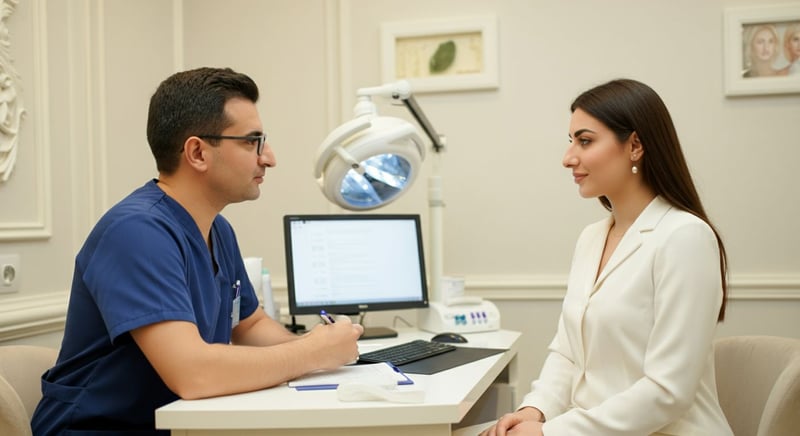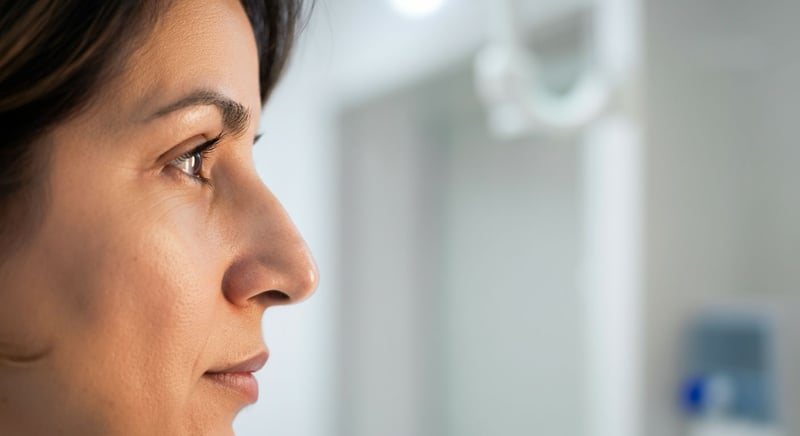Rhinoplasty: Reshape Your Nose, Transform Your Confidence
Rhinoplasty at estethica offers expert solutions for cosmetic and functional needs, enhancing both your appearance and breathing.
Exploring the profound impact rhinoplasty can have on both your appearance and self-confidence, this comprehensive guide delves into everything you need to know about the procedure. From understanding the multifaceted benefits to navigating the recovery process, rhinoplasty is more than just cosmetic enhancement—it's a lifestyle change.
Understanding Rhinoplasty: More Than Just a Nose Job
Exploring the Functional Benefits of Rhinoplasty
While often perceived as a cosmetic procedure, rhinoplasty, or a nose job, significantly improves nasal function. Deviated septums corrected during the surgery can ease breathing difficulties. This dual benefit—aesthetic enhancement and functional improvement—makes rhinoplasty a versatile option for individuals seeking both better looks and improved health. For instance, correcting structural abnormalities can lead to increased airflow, minimizing reliance on decongestants.
- Improved Breathing: Correcting a deviated septum allows for better airflow, alleviating chronic congestion.
- Sinus Pressure Relief: Rhinoplasty can reduce sinus pressure by addressing structural issues affecting drainage.
- Enhanced Sleep Quality: By improving nasal airflow, rhinoplasty can mitigate snoring and sleep apnea.
Ethnic Rhinoplasty, tailored to preserve and respect the patient's ethnic identity, considers these functional aspects alongside aesthetic goals. This ensures that the procedure enhances both appearance and nasal function, maintaining harmony with the individual’s cultural background. Moreover, this specialized approach addresses unique anatomical differences, resulting in outcomes that align with patients' expectations and cultural values.
Rhinoplasty Techniques: Open vs. Closed Approaches
Rhinoplasty employs two primary surgical techniques: open and closed. The open rhinoplasty involves a small incision between the nostrils to access the underlying nasal structures directly. This approach provides the surgeon with enhanced visibility and control. The closed rhinoplasty, on the other hand, involves incisions made inside the nose, minimizing external scarring. Each method has its own set of advantages depending on the complexity of the required corrections and the surgeon's expertise. Choosing the correct technique is paramount for achieving optimal results, tailored to the individual patient's anatomy and aesthetic desires.
- Initial Consultation: The surgeon assesses the patient's nasal structure and discusses aesthetic goals.
- Surgical Planning: The surgeon determines the most appropriate technique (open or closed) for achieving the desired outcome.
- Post-operative Care: Patients receive detailed instructions for recovery, including pain management and follow-up appointments.
The recovery process after rhinoplasty is a critical aspect of ensuring successful outcomes. Following post-operative instructions diligently helps minimize complications and ensures optimal healing. Non surgical rhinoplasty, also known as liquid nose job, offers a non-invasive alternative for minor corrections, utilizing injectable fillers to reshape the nose without surgery.

Rhinoplasty for Functionality: Fixing Breathing Problems & Deviated Septums
Correcting Deviated Septums Through Rhinoplasty
Functional rhinoplasty addresses internal nasal structures, focusing on resolving breathing difficulties and sinus issues. One common problem it corrects is a deviated septum, where the cartilage and bone dividing the nasal cavity are misaligned. This misalignment can obstruct airflow, leading to chronic congestion, nosebleeds, and repeated sinus infections. By surgically straightening the septum, functional rhinoplasty improves airflow, reduces these symptoms, and enhances overall breathing comfort. The benefits also include diminished snoring and better sleep quality, contributing significantly to a healthier life.
- Improved Nasal Airflow: Straightening the septum maximizes airflow through the nasal passages.
- Reduced Sinus Infections: Correcting structural issues minimizes sinus blockage and reduces vulnerability to infections.
- Better Sleep Quality: Improved nasal breathing helps diminish snoring and alleviates symptoms of sleep apnea.
The Holistic Impact of Functional Rhinoplasty
Functional rhinoplasty extends beyond mere symptom relief, contributing to overall well-being and an active lifestyle. Improved breathing can boost energy levels, enhance physical performance, and reduce reliance on medications for congestion. This holistic approach enhances patients' day-to-day lives, enabling them to engage more fully in sports, outdoor activities, and social interactions without the impediment of breathing problems. Ethsteca Global understands the importance of improving your medical condition with rhinoplasty. With a functional rhinoplasty, also an opportunity to reshape and resize the nose to match your facial proporties can make you feel a newer and better version of yourself. This is achieved while maintaining or improving nasal function. The surgery is customized according to the shape that suits your face, giving natural-looking and beautiful results.
- Initial Consultation: The surgeon assesses the patient's nasal structure and discusses their breathing problems.
- Surgical Procedure: With closed rhinoplasty or open rhinoplasty, the surgeon repairs the structural problems inside that causes breathing problems.
- Post-operative Care: Patients follow post-operative instructions diligently to get rid of swelling etc.

Ethnic Rhinoplasty: Tailoring the Procedure to Your Unique Features
Preserving Cultural Identity in Rhinoplasty
Ethnic rhinoplasty is a specialized surgical approach that respects and preserves the unique characteristics of various ethnic noses while enhancing overall facial harmony. Unlike traditional rhinoplasty, which sometimes aims for a uniform aesthetic, ethnic rhinoplasty focuses on refining the nose in a way that complements the patient's ethnic background. During the procedure, the surgeon should consider factors such as skin thickness, nasal structure, and the proportions of the face that are typical of that ethnicity. For example, Esthetica Global surgeons specialize in this approach, enhancing unique features while ensuring natural-looking results that honor each patient's heritage. Ultimately, the goal is to improve the nose's appearance without erasing a patient’s cultural identity.
- Preservation of Unique Traits: Ethnic rhinoplasty maintains distinctive ethnic nasal features.
- Harmonious Integration: The surgical plan ensures the enhanced nose complements the patient's other facial features.
- Cultural Respect: The procedure respects and celebrates the patient's ethnic heritage.
Techniques Tailored for Ethnic Rhinoplasty
Effective ethnic rhinoplasty involves customized surgical techniques designed to address the specific anatomical differences and aesthetic preferences of various ethnic groups. These techniques include precise reshaping of the nasal tip, bridge augmentation, and nostril modification, all while paying close attention to maintaining ethnic characteristics. The choice of technique depends on the patient’s unique anatomy and desired outcome. By employing these specialized methods, surgeons can achieve results that not only enhance the nose but also harmonize with the patient's ethnic identity. A skilled surgeon is aware of the balance of preserving a patient’s heritage while improving their medical condition. Each procedure is carefully customized to enhance and refine the nose to match the patient’s face proportion.
- Detailed Consultation: The surgeon assesses the patient's nasal structure and discusses aesthetic goals, considering their ethnic background.
- Customized Surgical Plan: The surgeon selects techniques to preserve the patient's ethnic features while enhancing the nose.
- Careful Execution: The surgery is performed with precision to achieve natural-looking results that honor the patient's heritage.

Rhinoplasty Recovery: What to Expect After Nose Surgery
Navigating the Initial Days Post-Rhinoplasty
Post-rhinoplasty, the initial week to ten days involves managing swelling and bruising. During this period, rest and adherence to post-operative guidelines are crucial for a smooth recovery. Patients often experience nasal congestion, which subsides as the nasal passages heal. estethica provides detailed aftercare instructions and support to guide patients through each stage, helping to minimize discomfort and optimize healing. For example, regular use of saline sprays is encouraged to keep nasal passages moist and prevent crusting.
- Rest and Elevation: Maintaining an elevated head position reduces swelling.
- Cold Compresses: Applying cold compresses helps minimize bruising and discomfort.
- Gentle Nasal Care: Saline sprays keep nasal passages moist.
Long-Term Recovery and Expected Outcomes
The complete healing process from rhinoplasty can take several months, with subtle refinements occurring as the tissues settle. Patients should avoid strenuous activities and protect their nose from trauma during this period. With advanced surgical techniques and comprehensive post-operative care, estethica ensures patients are well-informed and supported throughout their journey toward achieving their desired results. Understanding the recovery timeline and following the surgeon's advice is key for a successful outcome after nose surgery.
- Follow-Up Appointments: Regular check-ups with the surgeon to monitor healing.
- Avoid Strenuous Activities: Refraining from heavy lifting and intense exercise.
- Protect the Nose: Taking precautions to prevent any accidental bumps or injuries.
Rhinoplasty: Everything You Need to Know
Advanced Rhinoplasty Techniques: Open vs. Closed Approaches for Optimal Results
Personalized Rhinoplasty: Tailoring Recovery and Care for Successful Outcomes
Frequently Asked Questions
What is Rhinoplasty and what are its benefits beyond cosmetic enhancements?
What is Ethnic Rhinoplasty and how does it differ from traditional Rhinoplasty?
What can I expect during the Rhinoplasty recovery process, and how can I ensure a smooth healing?
How does functional Rhinoplasty address breathing problems and deviated septums?
What are the key differences between open and closed Rhinoplasty techniques, and how does each benefit patients?
Ready to discover the beauty of a healthier you with estethica's world-class aesthetic services?
📞 Call for Your Free Consultation!